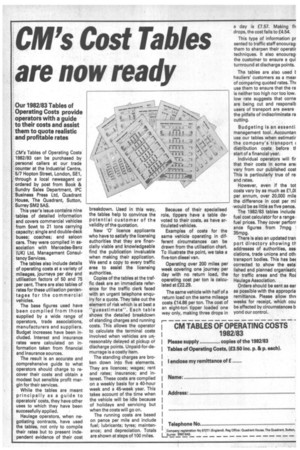CIWs cost Tables are now ready
Page 34

If you've noticed an error in this article please click here to report it so we can fix it.
Our 1982/83 Tables of Operating Costs provide operators with a guide to their costs and assist them to quote realistic and profitable rates
CM'S Tables of Operating Costs 1982/83 can be purchased by personal callers at our trade counter at the industrial Centre, 5/7 Hopton Street, London, SE1, >through a local newsagent or ; ordered by post from Book & ; Sundry Sales Department, 1PC z:Business Press Ltd, Quadrant ;. House, The Quadrant, Sutton, ;Surrey SM2 5AS.
, This year's issue contains nine tables of detailed information and covers commercial vehicles from 5cwt to 21 tons carrying capacity; single and double-deck buses; coaches; and saloon cars. They were compiled in association with Mercedes-Benz ILA) Ltd, Management Consultancy Services.
The tables also include details of operating costs at a variety of mileages, journeys per day and utilisation factors of 50 and 75 per cent. There are also tables of • rates for these utilisation percen • tages for the commercial • vehicles.
The base figures used have been compiled from those supplied by a wide range of operators, trade associations, manufacturers and suppliers. Budget increases have been included. Interest and insurance rates were calculated on information taken from financial and insurance sources.
The result is an accurate and comprehensive guide to what operators should charge to recover their costs and obtain a modest but sensible profit margin for their services.
While the tables are meant principalfy as a guide to operatoes' costs, they have other uses to which they have been successfully applied.
Haulage operators, when negotiating contracts, have used the tables, not only to compile their rates but to present independent evidence of their cost breakdown. Used in this way, the tables help to convince the potential customer of the validity of the quotation.
New '0' licence applicants who have to satisfy the licensing authorities that they are financially viable and knowledgeable find the publication invaluable when making their application. We send a copy to every traffic area to assist the licensing authorities.
Copies of the tables at the traffic desk are an immediate reference for the traffic clerk faced with an urgent telephone enquiry for a quote. They take out the element of risk which is at best a "guesstimate". Each table shows the detailed breakdown of standing charges and running costs. This allows the operator to calculate the terminal costs involved when vehicles are unreasonably delayed at pickup or discharge points. Unpaid-for-demurrage is a costly item.
The standing charges are broken down into five elements. They are licences; wages; rent and rates; insurance; and interest. These costs are compiled on a weekly basis for a 40-hour week and a 45-week year. This takes account of the time when the vehicle will be idle because of holidays and servicing but when the costs will go on.
The running costs are based on pence per mile and include fuel; lubricants; tyres; maintenance; and depreciation. Totals are shown at steps of 100 miles, Because of their specialised role, tippers have a table devoted to their costs, as have articulated vehicles.
Examples of costs for the same vehicle operating in different circumstances can be drawn from the utilisation chart. To illustrate the point, we take a five-ton diesel van.
Operating over 200 miles per week covering one journey per day with no return load, the operating cost per ton is calculated at £22.29.
The same vehicle with half of a return load on the same mileage costs £14.86 per ton. The cost of an eight-ton tipper loaded one way only, making three drops in a day is £7.57. Making fh drops, the cost fails to £4.54.
This type of information pr sented to traffic staff encouragi them to sharpen their operatir techniques. It also encouragi the customer to ensure a qui, turnround at discharge points.
The tables are also used t hauliers' customers as a mear 'of comparing quoted rates. Th( use them to ensure that the ra is neither too high nor too low. low rate suggests that carne are being cut and responsib users of transport are aware the pitfalls of indiscriminate ra cutting.
Budgeting is an essenti. management tool. Accountan use our tables when estimatir the company's transport distribution costs before tt start of a financial year.
Individual operators will fir that their costs in some arer vary from our published cost This is particularly true of re' and rates.
However, even if the tot costs vary by as much as £1,0( per annum, over 20,000 mile the difference in cost per mi • would be as little as five pence. The 1982/83 tables include fuel cost calculator for a range I fuel prices. They cover perforn ance figures from 7mpg 35mpg, There is also an updated tran port directory showing th addresses of authorities, ass' ciations, trade unions and othi transport bodies. This has bee corrected to show the estal lished and planned organisatic for traffic areas and the Rc4 Haulage Association.
Orders should be sent as ear as possible with the appropria. remittance. Please allow thrt weeks for receipt, which cou be affected by circumstances b yond our control.


















































































































